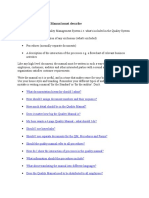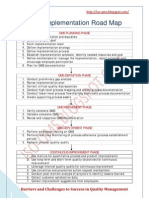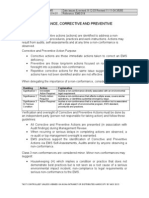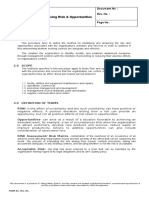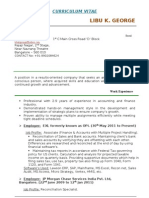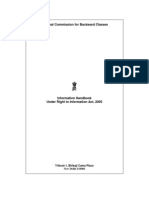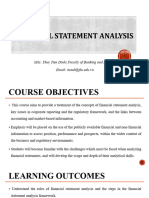ISO9001 Implementation Guidelines 2012
Uploaded by
mugilanISO9001 Implementation Guidelines 2012
Uploaded by
mugilanGQV CONSULTING, INDIA
ISO9001: 2008 IMPLEMENTATION KIT
PROJECT IMPLEMENTATION GUIDELINES
Sections:
1. Introduction
2. Project Planning
3. Documentation
4. Training
5. Implementation
6. Internal Audits
7. Selection of Auditing (Certification) Agency
8. Pre-assessment by Certification Agency
9. Preparing for Final Assessment (Certification)
10. Final Assessment and Beyond.
1. INTRODUCTION
Congratulations for your decision to build a customer-centric Quality Management System for your
organisation. Best wishes for successful ISO9001: 2008 project implementation.
The purpose of this document is to give an overview of how to develop and implement an ISO9001:
2008 compliant Quality Management System (QMS) in your organisation and get it certified to
ISO9001: 2008 by an accredited certifying agency.
First of all, please believe that you can do it ! Be confident, have perseverance, learn to be patient.
ISO9001: 2008 is a management system standard published by the International Organisation for
Standardisation, which states the requirements for a quality management system. To be certified as
an ISO9001: 2008 organisation, your firm needs to comply with the applicable requirements of the
standard.
Kindly note that meeting the requirements of a standard (and getting the ISO9001: 2008 certificate)
is like securing 60% marks in an examination.
You need to score 100% to become a truly world-class organisation, which can be done in phases
over a period of time, ideally after getting the ISO9001: 2008 accreditation. (What we mean by this
is to restrict the scope of your ISO9001: 2008 implementation activities to the minimal requirements
for certification in order to achieve the results in reasonable time.)
Visit us at http://www.GlobalQualityVillage.com Page 1 of 9
GQV CONSULTING, INDIA
ISO9001: 2008 IMPLEMENTATION KIT
PROJECT IMPLEMENTATION GUIDELINES
2. PROJECT PLANNING
As the system development-implementation-certification is essentially a project, it is essential to
identify the work elements and plan this project with a defined start date and end date.
The following table lists out major work elements and the management level responsible.
Sl. No Activity Activity Details Responsibility
1 Project Planning - To decide about the start date and end Top Management
date for the ISO9001 project. Usually it
takes between 3 to 6 months for QMS
development, implementation and
certification.
- To decide about the scope of ISO9001: Top Management
2008 certification (which offices /
factories / warehouses and which
products / services to be included)
- To nominate a senior member of the Top Management
management as “Management
Representative (MR)” who will have the
authority to get things done, cutting
across functional areas / departments. For
small companies, one of the owners /
directors can be the MR. In case of large
companies, the head of Quality
Assurance department would be the ideal
candidate.
- To nominate a junior level manager / Top Management
executive as the “QMS Co-ordinator” to / MR
assist the MR. This person can be from
any department, but with computer skills.
He/she should be hard working, good in
paperwork and also acceptable to most of
the departments.
- To convene a meeting of all Department Top Management
Heads and briefing about the company’s
decision to go for ISO9001, nomination
of MR and QMS Co-ordinator, and also
about the project completion time frame.
Visit us at http://www.GlobalQualityVillage.com Page 2 of 9
GQV CONSULTING, INDIA
ISO9001: 2008 IMPLEMENTATION KIT
PROJECT IMPLEMENTATION GUIDELINES
Sl. No Activity Activity Details Responsibility
2 Documentation - Understanding the present system of MR and QMS
management. Co-ordinator
- Comparing with the Sample Manuals and -do-
Formats.
- Customising the sample manuals and -do-
formats and adding / dropping some
documents if required.
- Issuing the manuals and formats for -do-
implementation
3 Training - To conduct an ISO9001: 2008 awareness MR / Head
training and familiarisation of QMS (Personnel)
Documents (Procedure Manuals and
Formats) for management personnel
including supervisors. (4 to 8 hours
duration)
- To conduct ISO9001: 2008 awareness MR / Head
training and familiarisation of QMS (Personnel)
Documents (Work Instruction Manuals
and Formats) for all workers. (2 to 4
hours duration)
- To conduct Internal Auditing Training MR / Head
for select group of Internal Auditors. (Personnel)
(Four hours classroom lecture followed
by hands-on training during 1st internal
audit)
4 Implementation - Implementation of system procedures Heads of
and work instructions and filling-up of Departments
quality system formats.
- Requesting changes in documents if Heads of
required Departments
- Document modification and issue of new MR
versions.
Visit us at http://www.GlobalQualityVillage.com Page 3 of 9
GQV CONSULTING, INDIA
ISO9001: 2008 IMPLEMENTATION KIT
PROJECT IMPLEMENTATION GUIDELINES
Sl. No Activity Activity Details Responsibility
5 Internal Audit - To conduct internal audits for assessment MR
of system implementation.
- To take corrective actions on audit Heads of
observations. Departments
- To follow-up and verify the status of MR
corrective actions.
6 Pre-assessment - To shortlist Certifying agencies, invite MR and Top
quotes and sign-up one agency. Management
- To schedule the pre-assessment dates MR
with the Certifying Agency and
communicate to HODs.
- To undergo Pre-Assessment and to take Heads of
corrective actions on audit observations. Departments
- To follow-up and verify the status of MR
corrective actions and send a report to the
certifying agency.
7 Final Assessment - To schedule the final-assessment dates MR
and Beyond with the Certifying Agency and
communicate to HODs.
- To undergo Final Assessment. Heads of
Departments
- If recommended for certification, to MR
follow-up with the Certifying Agency
and collect the certificate and logo etc.
- If not recommended for certification, to MR
ensure that corrective actions are taken
on the serious non-conformances
observed by the certifying agency and to
schedule a follow-up audit by the
Certifying Agency. (This process will
continue till Certification)
Visit us at http://www.GlobalQualityVillage.com Page 4 of 9
GQV CONSULTING, INDIA
ISO9001: 2008 IMPLEMENTATION KIT
PROJECT IMPLEMENTATION GUIDELINES
Sl. No Activity Activity Details Responsibility
7… Final Assessment - To take corrective actions on audit Heads of
and Beyond observations. Departments
- (Beyond certification) To follow-up and MR
verify the status of corrective actions on
minor observations by the Certifying
Agency and to send a report to the
Certifying Agency within the stipulated
time.
Now let us make a week-by-week project schedule of the above activities spanning 15 weeks.
Week Number
Sl. Activity
10
11
12
13
14
15
No.
1
2
3
4
5
6
7
8
9
1 Project Planning
2 Documentation
3 Training
4 Implementation
5 Internal Audit
6 Pre Assessment
7 Final Assessment
Visit us at http://www.GlobalQualityVillage.com Page 5 of 9
GQV CONSULTING, INDIA
ISO9001: 2008 IMPLEMENTATION KIT
PROJECT IMPLEMENTATION GUIDELINES
3. DOCUMENTATION
It is essentially a time consuming job to be done by the MR and QMS Co-ordinator. But it is very
vital for the success of your ISO9001 project.
As a first step, go from one department to the other, talk to the Head of the department and others
and …
- Understand the present system (what they do there).
- Construct an organisation chart for each department (with designations and the names of persons
currently holding the designation).
- Make a flow chart of sequence of activities for better understanding.
- Identify the persons responsible for various job elements.
- Note down the authority (span of control) of the persons.
- List down the manuals / procedures (if any) that are already being followed. If possible, get a
copy.
- Also list down the various activity records of internal / external origin and the purpose of
keeping these records.
Second step is to compare the activities and activity records of the existing system with the sample
procedures and formats given in the Documentation Kit. At this point, you MUST read the
“Document Customisation Guidelines” given in the Kit and make your organisation’s Quality
Manual in the same sequence (reading sequence) recommended in this guideline document.
Regarding formats (forms), if an existing record resembles one of that is given in the Kit, merge the
two and retain the format number of sample format. This way, implementation will be faster.
As a third step, present the applicable sections of the manual and formats to the Heads of each
department and ask for suggestions for modifications. Modify the manual and formats on the basis
of this input.
The fourth step would be to release the first version of manuals and formats for implementation.
Please read the quality system procedure for Document Control (QSP-04-02-A) in the Kit for details
of document numbering, issuing etc.
You can expect people to send many document change requests during implementation. Please
follow the system outlined in QSP-04-02-A.
Visit us at http://www.GlobalQualityVillage.com Page 6 of 9
GQV CONSULTING, INDIA
ISO9001: 2008 IMPLEMENTATION KIT
PROJECT IMPLEMENTATION GUIDELINES
4. TRAINING
Please note that ISO9001: 2008 (concept as well as the practical implications) WILL BE Greek and
Latin to most of the people in your organisation. As high calibre professionals excelling in their own
functional area, they may not want to openly request any training.
You must conduct in-house training programmes for all levels of personnel (both employees and
employers) in order to make them familiar with ISO9001: 2008 and the QMS documentation you
have just released.
You can either use the Power Point Training Slides prepared by us (GQV Consulting) or prepare
your own. Faculty may be from within the organisation or hired for the purpose.
Records of training attendance, participant feedback and class tests must be kept.
(Please read QSP-06-02-A for better understanding of Training & HRD.)
5. IMPLEMENTATION
Once the quality manuals and formats are issued, it is the time for implementation.
Please understand this point clearly: By implementation what we mean is the implementation of
system procedures and work instructions as per the issued manuals, NOT as per what people think it
should be / existing practices.
There can be many queries from various quarters about form filling. Please refer the “Filled
Formats” given in the Documentation Kit for help.
It is a good practice for the MR / QMS Co-ordinator to make weekly visits to all departments and
help the people understand the procedures and forms. Sometimes you need to help the people to
create computer files where form filling is electronic (in such cases, you need to give a softcopy of
the formats along with the hard copies).
It is helpful if the top management convenes two or three review meetings and takes implementation
feedback from Heads of Departments. Too many meetings to be avoided, as it is costly to the
organisation.
The MR is authorised to ensure smooth implementation of the QMS. Use this power judiciously.
Visit us at http://www.GlobalQualityVillage.com Page 7 of 9
GQV CONSULTING, INDIA
ISO9001: 2008 IMPLEMENTATION KIT
PROJECT IMPLEMENTATION GUIDELINES
6. INTERNAL AUDITS
Internal audits are vital in QMS implementation.
Please read the procedure QSP-08-02-B for details.
At least one internal audit (and subsequent management review) must be completed before pre-
assessment by the Certifying Agency.
7. SELECTION OF AUDITING (CERTIFICATION) AGENCY
There are more than 700 Certifying Agencies worldwide who are authorised to conduct assessments
and issue the ISO9001: 2008 certificate. Many are fly-by-night operators without any credibility in
the market. Be careful while selecting one.
Due to professional reasons we cannot say who is not reputed. However the following agencies are
considered to be reputed: BVQI, BSI, DNV, IRQS, LRQA, SGS, TUV, and UL. There may be
many others who are equally reputed.
Please visit our website at http://www.globalqualityvillage.com to send a quotation request to various
auditing agencies operating in India. Please fill the online forms and send quotation requests to
some of the auditing agencies in your city / nearby cities. (If you select an auditing agency from a
far-off place, you need to pay the airfare, which can be more than the audit fee !)
First you need to fill-up a “Request For Quote” form given by the agency and send it across. Then
they will send a detailed quote.
Study the quotes of 3 to 4 agencies and decide about one. Contact the chosen one and sign the
contract.
After sign-up, the auditing agency would ask for your quality manual to review its adequacy. Also
they need your manual for preparing their audit checklist.
8. PRE-ASSESSMENT BY CERTIFICATION AGENCY
The basic purpose of pre-assessment is to get a feel of what the auditing agency is looking for.
Some agencies are very stringent, while others are very lenient. You need to implement almost all
the suggestions made by the auditor. Corrective actions MUST be taken on the non-conformance
notes and observations raised by the auditors.
Visit us at http://www.GlobalQualityVillage.com Page 8 of 9
GQV CONSULTING, INDIA
ISO9001: 2008 IMPLEMENTATION KIT
PROJECT IMPLEMENTATION GUIDELINES
9. PREPARING FOR FINAL ASSESSMENT (CERTIFICATION)
Please note that the auditors will first check whether suitable corrective actions have been taken on
their observations during pre-assessment.
It is recommended to carry out the 2nd internal audit and complete corrective actions before the
Final Assessment.
10. FINAL ASSESSMENT AND BEYOND.
Usually, final assessment would pass off as a peaceful day, though you may be the most anxious.
In case the auditors find only minor non-conformances, your organisation will be recommended for
certification. You need to take corrective actions which will be verified in the subsequent
surveillance audit (after six / twelve months). Actual certificate and the artwork of Auditing
Agency’s Logo (with instructions for use) will reach you after 4 to 6 weeks of successful final
assessment.
In the event of finding major non-conformances (very rare event) you need to take corrective action
and undergo further audit (follow-up audit) before eventual certification.
Important Notes:
a. There is a tendency for many organisations to go slow on ISO9001 implementation after
achieving certification. It is the job of the MR to monitor and detect such slackness and bring
the system back to normal. The best way to achieve this is to conduct quarterly internal audits
and follow-up the status of corrective actions.
b. After achieving the ISO9001 certification, you may plan for implementation of improvement
tools such as Statistical Process Control (SPC), Engineering Process Control (EPC), Six Sigma
Initiatives etc.
Visit us at http://www.GlobalQualityVillage.com Page 9 of 9
You might also like
- National Open University of Nigeria: Fabric Shop Business Plan100% (3)National Open University of Nigeria: Fabric Shop Business Plan13 pages
- ISO 9001 2015 Gap Analysis Checklist sampleXXNo ratings yetISO 9001 2015 Gap Analysis Checklist sampleXX6 pages
- Quality Management Vs Quality Assurance June 20170% (1)Quality Management Vs Quality Assurance June 20172 pages
- 014.01 Non-Conformance Corrective and Prev Action 2No ratings yet014.01 Non-Conformance Corrective and Prev Action 23 pages
- Generic Manual On ISO 9001 Six Mandatory ProceduresNo ratings yetGeneric Manual On ISO 9001 Six Mandatory Procedures80 pages
- Financial Customer / Client Internal Processes Learning and GrowthNo ratings yetFinancial Customer / Client Internal Processes Learning and Growth1 page
- Afis Quality Manual 2015 Rev 04 14032015No ratings yetAfis Quality Manual 2015 Rev 04 1403201524 pages
- QSP 7.1-03 Control of Organizational Knowledge (Preview)100% (2)QSP 7.1-03 Control of Organizational Knowledge (Preview)4 pages
- AS9100 Quality Manual: Origination Date: January 25, 2007No ratings yetAS9100 Quality Manual: Origination Date: January 25, 200737 pages
- Compariosn Between IATF and TS RequirementsNo ratings yetCompariosn Between IATF and TS Requirements32 pages
- Iso 9001:2000 Audit Checklist: 4 Quality Management System Status Notes100% (1)Iso 9001:2000 Audit Checklist: 4 Quality Management System Status Notes9 pages
- 21.1 Appendix 1 ISO 9001 2015 Internal Audit Checklist Integrated Preview EN100% (2)21.1 Appendix 1 ISO 9001 2015 Internal Audit Checklist Integrated Preview EN2 pages
- Iso 9000 and Total Quality: The Relationship: Introduction To Quality Management Tell 26100% (1)Iso 9000 and Total Quality: The Relationship: Introduction To Quality Management Tell 2625 pages
- ISO 9001 2015 Gap Analysis Checklist Sample PDFNo ratings yetISO 9001 2015 Gap Analysis Checklist Sample PDF4 pages
- (TQM IQA 005 (001) ) Observations OFI Report FormNo ratings yet(TQM IQA 005 (001) ) Observations OFI Report Form1 page
- (Enter Company Logo/Name) : Title: Corrective and Preventive Action (CAPA) ProcessNo ratings yet(Enter Company Logo/Name) : Title: Corrective and Preventive Action (CAPA) Process6 pages
- ISO 9001:2015 Awareness Trainng Program: © ABI ConstructionNo ratings yetISO 9001:2015 Awareness Trainng Program: © ABI Construction52 pages
- Summary of New QMS Documents With References To ISO 9001 & IATF 16949 Clauses100% (2)Summary of New QMS Documents With References To ISO 9001 & IATF 16949 Clauses8 pages
- BSI ISO 9001 Self Assessment Checklist PDFNo ratings yetBSI ISO 9001 Self Assessment Checklist PDF2 pages
- 9100-2016 Series Clarification Table 10-2019100% (1)9100-2016 Series Clarification Table 10-201921 pages
- Correlation Matrices Between ISO 9001:2015, ISO 14001:2015, ISO DIS2 45001:2017 & Xyz Integrated Management..No ratings yetCorrelation Matrices Between ISO 9001:2015, ISO 14001:2015, ISO DIS2 45001:2017 & Xyz Integrated Management..5 pages
- Physical configuration audit Complete Self-Assessment GuideFrom EverandPhysical configuration audit Complete Self-Assessment GuideNo ratings yet
- Stipend Reimbursement Process Under NAPSNo ratings yetStipend Reimbursement Process Under NAPS3 pages
- Full download ISE Advanced Financial Accounting 13th Edition Theodore E. Christensen pdf docx100% (1)Full download ISE Advanced Financial Accounting 13th Edition Theodore E. Christensen pdf docx66 pages
- Module 3 - Construction Project ManagementNo ratings yetModule 3 - Construction Project Management17 pages
- Audit Quality and Accounting Going Concern Evidence From Listed Non-Financial Firms in NigeriaNo ratings yetAudit Quality and Accounting Going Concern Evidence From Listed Non-Financial Firms in Nigeria10 pages
- National Commission For Backward Classes: Trikoot-1, Bhikaji Cama Place New Delhi-110066No ratings yetNational Commission For Backward Classes: Trikoot-1, Bhikaji Cama Place New Delhi-11006665 pages
- 21063_20250328121434_audit_program_statutory_bank_branch_audit_program_2024_25 (1)No ratings yet21063_20250328121434_audit_program_statutory_bank_branch_audit_program_2024_25 (1)12 pages
- Writing a Roofing Company Business Plan [Sample Template]No ratings yetWriting a Roofing Company Business Plan [Sample Template]22 pages
- Accounting For Players Contracts of Baseball Club.No ratings yetAccounting For Players Contracts of Baseball Club.3 pages
- Download full Mathematical Modeling 4th Edition Meerschaert Solutions Manual all chapters100% (3)Download full Mathematical Modeling 4th Edition Meerschaert Solutions Manual all chapters52 pages
- MSC Accounting Seminar Paper On Forensic Audit100% (1)MSC Accounting Seminar Paper On Forensic Audit26 pages
- National Open University of Nigeria: Fabric Shop Business PlanNational Open University of Nigeria: Fabric Shop Business Plan
- 014.01 Non-Conformance Corrective and Prev Action 2014.01 Non-Conformance Corrective and Prev Action 2
- Generic Manual On ISO 9001 Six Mandatory ProceduresGeneric Manual On ISO 9001 Six Mandatory Procedures
- Financial Customer / Client Internal Processes Learning and GrowthFinancial Customer / Client Internal Processes Learning and Growth
- QSP 7.1-03 Control of Organizational Knowledge (Preview)QSP 7.1-03 Control of Organizational Knowledge (Preview)
- AS9100 Quality Manual: Origination Date: January 25, 2007AS9100 Quality Manual: Origination Date: January 25, 2007
- Iso 9001:2000 Audit Checklist: 4 Quality Management System Status NotesIso 9001:2000 Audit Checklist: 4 Quality Management System Status Notes
- 21.1 Appendix 1 ISO 9001 2015 Internal Audit Checklist Integrated Preview EN21.1 Appendix 1 ISO 9001 2015 Internal Audit Checklist Integrated Preview EN
- Iso 9000 and Total Quality: The Relationship: Introduction To Quality Management Tell 26Iso 9000 and Total Quality: The Relationship: Introduction To Quality Management Tell 26
- (Enter Company Logo/Name) : Title: Corrective and Preventive Action (CAPA) Process(Enter Company Logo/Name) : Title: Corrective and Preventive Action (CAPA) Process
- ISO 9001:2015 Awareness Trainng Program: © ABI ConstructionISO 9001:2015 Awareness Trainng Program: © ABI Construction
- Summary of New QMS Documents With References To ISO 9001 & IATF 16949 ClausesSummary of New QMS Documents With References To ISO 9001 & IATF 16949 Clauses
- Correlation Matrices Between ISO 9001:2015, ISO 14001:2015, ISO DIS2 45001:2017 & Xyz Integrated Management..Correlation Matrices Between ISO 9001:2015, ISO 14001:2015, ISO DIS2 45001:2017 & Xyz Integrated Management..
- Physical configuration audit Complete Self-Assessment GuideFrom EverandPhysical configuration audit Complete Self-Assessment Guide
- Full download ISE Advanced Financial Accounting 13th Edition Theodore E. Christensen pdf docxFull download ISE Advanced Financial Accounting 13th Edition Theodore E. Christensen pdf docx
- Audit Quality and Accounting Going Concern Evidence From Listed Non-Financial Firms in NigeriaAudit Quality and Accounting Going Concern Evidence From Listed Non-Financial Firms in Nigeria
- National Commission For Backward Classes: Trikoot-1, Bhikaji Cama Place New Delhi-110066National Commission For Backward Classes: Trikoot-1, Bhikaji Cama Place New Delhi-110066
- 21063_20250328121434_audit_program_statutory_bank_branch_audit_program_2024_25 (1)21063_20250328121434_audit_program_statutory_bank_branch_audit_program_2024_25 (1)
- Writing a Roofing Company Business Plan [Sample Template]Writing a Roofing Company Business Plan [Sample Template]
- Accounting For Players Contracts of Baseball Club.Accounting For Players Contracts of Baseball Club.
- Download full Mathematical Modeling 4th Edition Meerschaert Solutions Manual all chaptersDownload full Mathematical Modeling 4th Edition Meerschaert Solutions Manual all chapters



